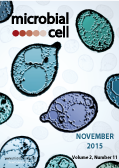Table of contents
Volume 2, Issue 11, pp. 412 - 453, November 2015
Cover: Electron microscopy micrograph of yeast wild type cells embedded in Spurr's resin and colored with uranyl and led citrate after sectioning. The original image was elaborated digitally. Image by Andri Fraenkl, Muriel Mari and Fulvio Reggiori (University of Groningen, The Netherlands); modified by MIC. The cover is published under the Creative Commons Attribution (CC BY) license.
Enlarge issue cover
Electron microscopy for ultrastructural analysis and protein localization in Saccharomyces cerevisiae
Andri Frankl, Muriel Mari and Fulvio Reggiori
Reviews |
page 412-428 | 10.15698/mic2015.11.237 | Full text | PDF |
Abstract
The yeast Saccharomyces cerevisiae is a key model system for studying of a multitude of cellular processes because of its amenability to genetics, molecular biology and biochemical procedures. Ultrastructural examinations of this organism, though, are traditionally difficult because of the presence of a thick cell wall and the high density of cytoplasmic proteins. A series of recent methodological and technical developments, however, has revived interest in morphological analyses of yeast (e.g. [1][2][3]). Here we present a review of established and new methods, from sample preparation to imaging, for the ultrastructural analysis of S. cerevisiae. We include information for the use of different fixation methods, embedding procedures, approaches for contrast enhancement, and sample visualization techniques, with references to successful examples. The goal of this review is to guide researchers that want to investigate a particular process at the ultrastructural level in yeast by aiding in the selection of the most appropriate approach to visualize a specific structure or subcellular compartment.
Oxygen availability strongly affects chronological lifespan and thermotolerance in batch cultures of Saccharomyces cerevisiae
Markus M.M. Bisschops, Tim Vos, Rubén Martínez-Moreno, Pilar de la Torre Cortés, Jack T. Pronk, Pascale Daran-Lapujade
Research Articles |
page 429-444 | 10.15698/mic2015.11.238 | Full text | PDF |
Abstract
Stationary-phase (SP) batch cultures of Saccharomyces cerevisiae, in which growth has been arrested by carbon-source depletion, are widely applied to study chronological lifespan, quiescence and SP-associated robustness. Based on this type of experiments, typically performed under aerobic conditions, several roles of oxygen in aging have been proposed. However, SP in anaerobic yeast cultures has not been investigated in detail. Here, we use the unique capability of S. cerevisiae to grow in the complete absence of oxygen to directly compare SP in aerobic and anaerobic bioreactor cultures. This comparison revealed strong positive effects of oxygen availability on adenylate energy charge, longevity and thermotolerance during SP. A low thermotolerance of anaerobic batch cultures was already evident during the exponential growth phase and, in contrast to the situation in aerobic cultures, was not substantially increased during transition into SP. A combination of physiological and transcriptome analysis showed that the slow post-diauxic growth phase on ethanol, which precedes SP in aerobic, but not in anaerobic cultures, endowed cells with the time and resources needed for inducing longevity and thermotolerance. When combined with literature data on acquisition of longevity and thermotolerance in retentostat cultures, the present study indicates that the fast transition from glucose excess to SP in anaerobic cultures precludes acquisition of longevity and thermotolerance. Moreover, this study demonstrates the importance of a preceding, calorie-restricted conditioning phase in the acquisition of longevity and stress tolerance in SP yeast cultures, irrespective of oxygen availability.
Micafungin induced apoptosis in Candida parapsilosis independent of its susceptibility to micafungin
Fazal Shirazi, Russel E. Lewis, Dimitrios P. Kontoyiannis
Research Reports |
page 445-450 | 10.15698/mic2015.11.236 | Full text | PDF |
Abstract
We hypothesized that the cell wall inhibitor micafungin (MICA) induces apoptosis in both MICA-susceptible (MICA-S) and MICA–non-susceptible (MICA-NS) Candida parapsilosis. Antifungal activity and apoptosis were analyzed in MICA-S and MICA-NS C. parapsilosis strains following exposure to micafungin for 3 h at 37°C in RPMI 1640 medium. Apoptosis was characterized by detecting phosphatidylserine externalization (PS), plasma membrane integrity, reactive oxygen species (ROS) generation, mitochondrial membrane potential changes, adenosine triphosphate (ATP) release, and caspase-like activity. Apoptosis was detected in MICA exposed (0.25 to 1 mg/L) susceptible C. parapsilosis strains and was associated with apoptosis of 20-52% of analyzed cells versus only 5-30% of apoptosis in MICA-NS cells exposed to micafungin (0.5 to 2 mg/L; P = 0.001). The MICA antifungal activity was correlated with apoptotic cells showing increased dihydrorhodamine-123 staining (indicating ROS production), Rh-123 staining (decreased mitochondrial membrane potential), elevated ATP, and increased metacaspase activity. In conclusion, MICA is pro-apoptotic in MICA-S cells, but still exerts apoptotic effects in MICA –NS C. parapsilosis.
Complex regulation of the sirtuin-dependent reversible lysine acetylation system of Salmonella enterica
Kristy L. Hentchel and Jorge C. Escalante-Semerena
Microreviews |
page 451-453 | 10.15698/mic2015.11.239 | Full text | PDF |
Abstract
The extensive involvement of the reversible lysine acylation (RLA) system in metabolism has attracted the attention of investigators interested in understanding the fundamentals of prokaryotic and eukaryotic cell function. Research in this area of cell physiology is diverse, ranging, among others, from probing the molecular bases of human diseases, to optimizing engineered metabolic pathways for biotechnological applications, to advancing our understanding of fundamental cellular processes. A gap of knowledge exists in our understanding of the regulatory circuitry that integrates the expression of genes encoding modifiers (i.e., acyltransferases) and demodifiers (i.e., deacylases) with the expression of genes encoding known targets of the system. Here we discuss the implications of recently reported work performed in the enteropathogen Salmonella enterica (mBio (2015) 6(4):e00891-15), which provided the first insights into the integration of the transcriptional regulation of genes encoding the RLA system with the acs gene encoding the central metabolic enzyme acetyl-CoA synthetase (Acs).










